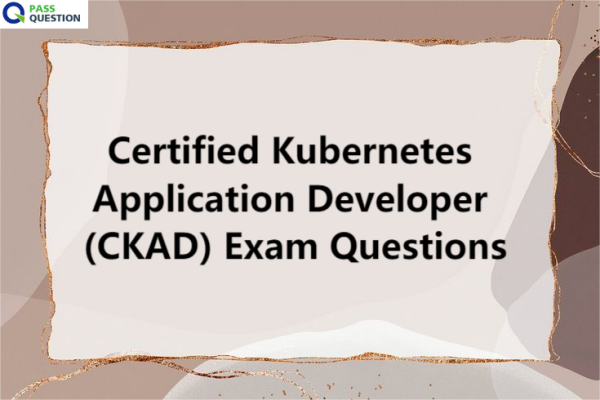Are you attempting Certified Kubernetes Application Developer (CKAD) Exam? PassQuestion provides the latest Certified Kubernetes Application Developer (CKAD) Exam Questions that will help you prepare for the real exam. By using our Certified Kubernetes Application Developer (CKAD) Exam Questions, you will be able to clear your CKAD Certification exam on the first attempt. It will help you build confidence and you will be able to find out important tips to attempt your CKAD exam. Make sure that you are focusing on going through our Certified Kubernetes Application Developer (CKAD) Exam Questions multiple times before attempting a real exam.

Certified Kubernetes Application Developer (CKAD) Exam
CKAD has been developed by The Linux Foundation and the Cloud Native Computing Foundation (CNCF), to help expand the Kubernetes ecosystem through standardized training and certification. This exam is an online, proctored, performance-based test that consists of a set of performance-based tasks (problems) to be solved in a command line. The Certified Kubernetes Application Developer exam certifies that users can design, build, configure, and expose cloud-native applications for Kubernetes. A Certified Kubernetes Application Developer can define application resources and use core primitives to build, monitor, and troubleshoot scalable applications and tools in Kubernetes.
The certification program allows users to demonstrate their competence in a hands-on, command-line environment. The purpose of the Certified Kubernetes Application Developer (CKAD) program is to provide assurance that CKADs have the skills, knowledge, and competency to perform the responsibilities of Kubernetes application developers.
Exam Information
Number of Questions: 19 questions
Duration: 2 hours
Passing score: 66%
Cost: $395 USD
Format: Multiple-choice questions
Type: performance-based exam
CKAD Exam Objectives
20% - Application Design and Build
- Define, build and modify container images
- Understand Jobs and CronJobs
- Understand multi-container Pod design patterns (e.g. sidecar, init and others)
- Utilize persistent and ephemeral volumes
20% - Application Deployment
- Use Kubernetes primitives to implement common deployment strategies (e.g. blue/ green or canary)
- Understand Deployments and how to perform rolling updates
- Use the Helm package manager to deploy existing packages
15% - Application observability and maintenance
- Understand API deprecations
- Implement probes and health checks
- Use provided tools to monitor Kubernetes applications
- Utilize container logs
- Debugging in Kubernetes
25% - Application Environment, Configuration and Security
- Discover and use resources that extend Kubernetes (CRD)
- Understand authentication, authorization and admission control
- Understanding and defining resource requirements, limits and quotas
- Understand ConfigMaps
- Create & consume Secrets
- Understand ServiceAccounts
- Understand SecurityContexts
20% - Services & Networking
- Demonstrate basic understanding of NetworkPolicies
- Provide and troubleshoot access to applications via services
- Use Ingress rules to expose applications
Certified Kubernetes Application Developer (CKAD) Exam Questions
Are you attempting Certified Kubernetes Application Developer (CKAD) Exam? PassQuestion provides the latest Certified Kubernetes Application Developer (CKAD) Exam Questions that will help you prepare for the real exam. By using our Certified Kubernetes Application Developer (CKAD) Exam Questions, you will be able to clear your CKAD Certification exam on the first attempt. It will help you build confidence and you will be able to find out important tips to attempt your CKAD exam. Make sure that you are focusing on going through our Certified Kubernetes Application Developer (CKAD) Exam Questions multiple times before attempting a real exam.
Certified Kubernetes Application Developer (CKAD) Exam
CKAD has been developed by The Linux Foundation and the Cloud Native Computing Foundation (CNCF), to help expand the Kubernetes ecosystem through standardized training and certification. This exam is an online, proctored, performance-based test that consists of a set of performance-based tasks (problems) to be solved in a command line. The Certified Kubernetes Application Developer exam certifies that users can design, build, configure, and expose cloud-native applications for Kubernetes. A Certified Kubernetes Application Developer can define application resources and use core primitives to build, monitor, and troubleshoot scalable applications and tools in Kubernetes.
The certification program allows users to demonstrate their competence in a hands-on, command-line environment. The purpose of the Certified Kubernetes Application Developer (CKAD) program is to provide assurance that CKADs have the skills, knowledge, and competency to perform the responsibilities of Kubernetes application developers.
Exam Information
Number of Questions: 19 questions
Duration: 2 hours
Passing score: 66%
Cost: $395 USD
Format: Multiple-choice questions
Type: performance-based exam
CKAD Exam Objectives
20% - Application Design and Build
20% - Application Deployment
15% - Application observability and maintenance
25% - Application Environment, Configuration and Security
20% - Services & Networking
Related Articles